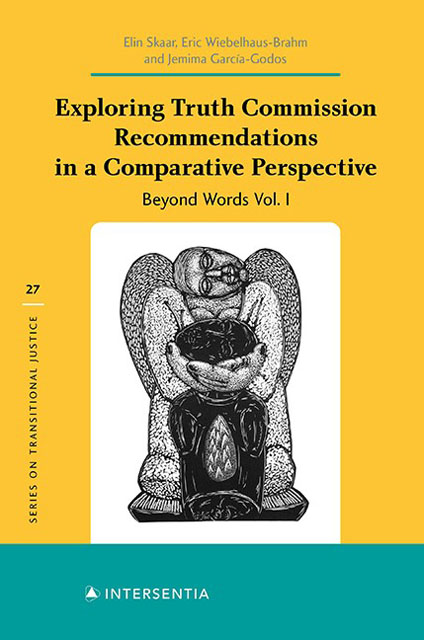Book contents
- Frontmatter
- Preface
- Contents
- List of Acronyms and Abbreviations
- List of Tables and Figures
- Chapter 1 Exploring Recommendations
- Chapter 2 Researching Recommendations
- Chapter 3 Counting and Classifying Recommendations
- Chapter 4 Formulating Recommendations
- Chapter 5 Case Studies of Implementation
- Chapter 6 A Cross-National Analysis of Implementation
- Chapter 7 Conclusions
- Appendix I Latin American truth Commission Reports
- Appendix II Information on 13 Latin American truth CommissionReports and their Recommendations
- Appendix III Excerpts from the truth Commission Recommendations Data Code Book
- Appendix IV Implementation of the Recommendations Made by 13 Latin American truth Commissions
- Appendix V Implementation Rates for Recommendations Made by 13 Latin American truth Commissions, by Category
- Appendix VI Overview of Commissioners of 12 Formal Latin American truth Commissions
- Appendix VII Latin American Countries Signatories to and Ratification of the International Convention for the Protection of All Persons from Enforced Disappearance (2006)
- Bibliography
- Index
- About the Authors
Chapter 2 - Researching Recommendations
Published online by Cambridge University Press: 19 November 2022
- Frontmatter
- Preface
- Contents
- List of Acronyms and Abbreviations
- List of Tables and Figures
- Chapter 1 Exploring Recommendations
- Chapter 2 Researching Recommendations
- Chapter 3 Counting and Classifying Recommendations
- Chapter 4 Formulating Recommendations
- Chapter 5 Case Studies of Implementation
- Chapter 6 A Cross-National Analysis of Implementation
- Chapter 7 Conclusions
- Appendix I Latin American truth Commission Reports
- Appendix II Information on 13 Latin American truth CommissionReports and their Recommendations
- Appendix III Excerpts from the truth Commission Recommendations Data Code Book
- Appendix IV Implementation of the Recommendations Made by 13 Latin American truth Commissions
- Appendix V Implementation Rates for Recommendations Made by 13 Latin American truth Commissions, by Category
- Appendix VI Overview of Commissioners of 12 Formal Latin American truth Commissions
- Appendix VII Latin American Countries Signatories to and Ratification of the International Convention for the Protection of All Persons from Enforced Disappearance (2006)
- Bibliography
- Index
- About the Authors
Summary
Words are but the signs of ideas.
– Samuel Johnson, lexicographer (1709 – 84)A truth commission recommendation is, in essence, a constellation of words that proposes an action that implies change. Behind each recommendation there is an idea – which we must assume that commissioners had in mind when issuing precisely this recommendation, formulated just so. Yet, it is not always straightforward to know what a recommendation is, or how it is meant to bring about the desired change. Presumably, that has to do with how and by whom the recommendation is implemented. Coming to grips with what a truth commission recommendation fundamentally is, is the task ahead.
This chapter provides a detailed discussion of the project’s methodology. We describe our methodological choices in depth. We explain how we constructed our database to facilitate cross-case comparison. Further, we discuss how we address questions of causality. On the surface, exploring truth commission recommendations seems like a relatively straightforward task: one must consult those who were involved in the formulation of recommendations; assemble a checklist of the recommendations which are outlined in truth commissions’ final reports; and check off the ones for which relevant action was taken. As with all research projects, the systematic study of truth commission recommendations has involved several methodological choices, some of them expected, others unexpected. Nevertheless, collecting systematic data on the hundreds of recommendations produced by 13 truth commissions, some dating back as far as 1984, across 11 countries, is a challenging endeavour.
As outlined in the previous chapter, we have two major interests in examining truth commission recommendations. First, we focus on the formulation of the recommendations themselves. We seek to understand why commissioners ended up with the particular set of recommendations they did and not others. In talking with commission staffand others who were involved in the process, we are cognizant of how the passage of time and interviewees’ desire to protect their legacy can create challenges for data analysis, among other things. Second, we focus on the implementation of the recommendations. We collect data on which of these recommendations have actually been implemented, taking into account nuances of the degree of implementation. Finally, we examine how the characteristics of recommendations as well as contextual factors shape the likelihood that particular types of recommendations get implemented.
- Type
- Chapter
- Information
- Exploring Truth Commission Recommendations in a Comparative Perspective: Beyond Words Vol 1 , pp. 25 - 44Publisher: IntersentiaPrint publication year: 2022

